Artists - W
|
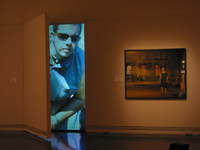
|
Craig Walsh (Australia) 
Born in 1966 in Orange, New South Wales, Australia. Lives
and works in Brisbane.
Walsh creates site-specific installations that are shown
in venues not only inside art museums. These include the installation
in which the glass doors of an urban building are transformed
at night into a water tank filled with huge fish (Blurring
the Boundaries, Hanoi, 2001), and commissioned work and
off-site projects such as that shown at the “Woodford Folk Festival” music
festival (Queensland). Walsh’s site-specific work encroaches
onto the site itself to transform its meaning. Apart from creating
his own art, Walsh is also a curator and coordinator of art
events. In Australia, Walsh’s work has been shown in
exhibitions such as “The Anne Landa Award” at the
Art Gallery of New South Wales in 2004, while he also participates
in international exhibitions such as the Havana Biennale, 2004.
Back to list
|
|
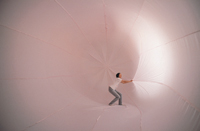
|
Wang Te-Yu (Taiwan) 
Born in 1970 in Shin-shu, Taiwan. Lives and works in Taipei.
Wang graduated from the Department of Fine Art, National
Institute of the Arts, Taipei in 1993. In recent years Wang
has participated in exhibitions such as “Sister Space” (Southern
Exposure, San Francisco, 2000), “You Talk,
I Listen” (Centre d’Art Contemporain de La Ferme
du Buisson, France, 1999), “PROMENADE IN ASIA - CUTE” (Mito
Art Tower, Japan, 2001) and “Lots o’LOTTO: Visible
and Invisible” (Taipei Fine Arts Museum, Taiwan, 2005).
Throughout her career Wang has continued to focus on a single
concept - the presence of people within a given space, human
intervention into space and the change that takes place as
a result. She departs from conventional art in with its
emphasis
on the visual element, instead attempting to evoke people’s
intuitive powers and awareness through the work that she
makes
accessible to the observer.
Back to list
|
|
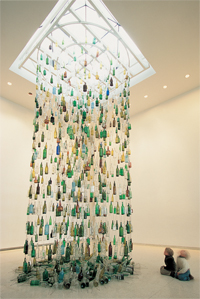
|
Nari Ward (Jamaica)

 Born in 1963 in St Andrews, Jamaica. Lives and works in New
York. Born in 1963 in St Andrews, Jamaica. Lives and works in New
York.
Ward studied art after migrating to the United States and then embarked
on a career as an artist, later shifted his focus to installations. The recycle
and reuse of the immense quantity of waste produced by American consumer
society remains a feature of his work. The dialogue with regional societies
and communities that result from this process of collecting refuse is also
an important element of his work. Participated in “Documenta 11” (2002)
and the 7th Sharjah International Art Biennial (2005).
Back to list
|
|
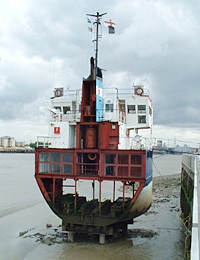
|
Richard Wilson (UK)

Born in 1953 in London, UK. Lives and works in London.
One of UK representative installation artists. Wilson’s “20:50” is
part of the Saatchi Gallery permanent collection in London. His large-scale
installation “Slice of Reality”(2000) featuring a cross-section
of a boat at the mouth of the Thames River in London was highly acclaimed.
Wilson’s site-specific works always convey a pointed and resonant message
about the environment that surrounds us.
Major works include Final Corner (World Cup Project, Fukuroi City, 2002),
Over Easy (Stockton, U.K., 1999), 20:50 (Saatchi Gallery, London, 2003) and
Slice of Reality (London, 2000).
Back to list
|
|
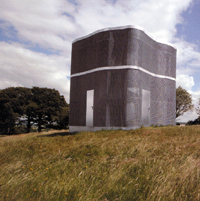
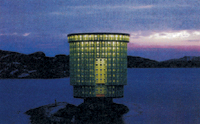
|
Wolfgang Winter & Berthold Hörbelt (Germany)
Wolfgang Winter (born in 1960 in Offenbach,
Germany. Lives and works in Frankfurt), and Berthold Hörbelt
(born in 1958 in Coesfeld, Germany. Lives and works in Frankfurt)
form
an
artistic duo known for their work Pavilion, constructed
with plastic crates used for transporting drinks.
Although Pavilion can be described as a “sculpture”
which the observer can enter and experience, Winter and Hörbelt’s
pavilions are often constructed as buildings with a function,
such as an information booth, a movie theater or a bus shelter.
In recent years, they have also been using a range of materials
other than crates to create a series of elegant structures,
often with half of the structure exposed to the outside world.
Recent exhibitions that Winter and Hörbelt have participated
in include “Tokachi International Contemporary Art Exhibition:
Demeter”(Obihiro, 2002), “2003 Beaufort, Triennial
for Contemporary Art by the Sea”(Ostend, Belgium, 2003),
“Purloined Nature” Kawamura Memorial Museum of
Art (Sakura, 2003). Their work is also represented at Yorkshire
Sculpture Park (Yorkshire, UK, 2004).
 Wolfgang
Winter and Berthold Hörbelt Wolfgang
Winter and Berthold Hörbelt
Back to list
|
|
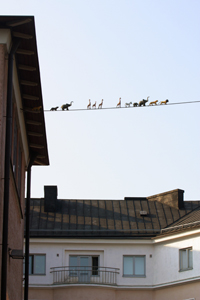
|
Maaria Wirkkala (Finland) 
Born in 1954 in Helsinki, Finland. Lives and works in Espoo.
After studying ceramics in Helsinki, Wirkkala went on to
study art in France.
As represented by Wirkkala’s installation at the 1995
Venice Biennale in which chairs were suspended from the
windows
of houses to hang above the streets to convey the sense of
absence of local residents during an international exhibition,
by bringing alive – in the exhibition space – concepts such
as “absence” and “loss”, Wirkkala’s
work reveals small memories and thoughts/hopes that are
normally
undetectable.
Major works include So What (Helsinki Festival, 2002)
and Forskarcellerna [Researcher’s Cells], (statenskonstråd,
2001), while Wirkkala has participated in many group exhibitions
such as the Istanbul Biennale (1995), the Venice Biennale
(2000) and Echigo-Tsumari Art Triennale (Niigata, 2003).
Back to list
|
|